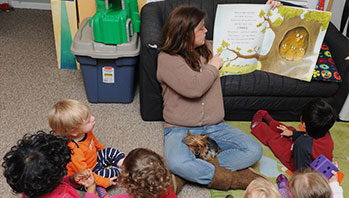- bat
- listen
- sound
MA Standards:
Literature/RL.PK.MA.1: With prompting and support, ask and answer questions about a story or a poem read aloud.
Literature/RL.PK.MA.9: With prompting and support, make connections between a story or poem and one’s own experiences.
Head Start Outcomes:
Literacy Knowledge/Book Appreciation and Knowledge: Asks and answers questions and makes comments about print materials.
PreK Learning Guidelines:
English Language Arts/Reading and Literature 6: Listen to a wide variety of age appropriate literature read aloud.
English Language Arts/Reading and Literature 10: Engage actively in read-aloud activities by asking questions, offering ideas, predicting or retelling important parts of a story or informational book.
Read Together: Oscar and the Bat: A Book About Sound #1

© Commonwealth of Massachusetts, Department of Early Education and Care (Jennifer Waddell photographer). All rights reserved.
STEM Key Concepts: Sounds have a source; Different objects make different sounds; Sounds vary in three ways: volume, pitch, and timbre
ELA Focus Skills: Concepts of Print, Make Connections, Speaking and Listening, Story Comprehension
Before You Read
Tell children you are going to read a book about two animals that listen to sounds with their ears--just like they do. Set a listening focus for children by asking them to listen for the different sounds you read about.
Hold up Oscar and the Bat: A Book About Sound by Geoff Waring. Read aloud the title and the name of the author/illustrator.
- Point to Oscar and ask, Do you know what kind of animal this is? Explain that Oscar is the name of the cat.
- Point to the bat and ask, Do you know what kind of animal this is? Ask children to explain what a bat is. Ask, What do you know about bats? Explain that bats are winged animals that are awake at night.
- Explain that this is a story about a bat, and the author decided to have the bat awake in the daytime. Ask: Why do you think he decided to do that? (you can track sounds more easily)
As You Read
Engage children in thinking and talking about what Oscar and the Bat say about sound. Pause often to encourage children to make connections to what they have been learning about sound. For example,
- On page 7, ask, What does Oscar hear that he can’t see? How does Bat know where the sound is coming from? Do you remember hearing sounds that you could not see? How did you know where they were coming from?
- On page 9, ask, What sound does Oscar think is the most beautiful sound he has ever heard? Do you remember what Chirp’s favorite sound is (from the PEEP and the Big Wide World video “Sounds Like…”)? It was also a bird!
After You Read
Ask children to summarize what they learned about animal sounds. Ask, What new animals did you learn about? What sounds do they make? Have children make the sounds as they respond.
Educator Tip: This book at first glance appears to be a simple conversation between a cat named Oscar and a bat named Bat; however, the science concepts embedded in their conversation gives a quick summary of many of the sound concepts that the children have been exploring during this unit. Keep the book handy during Discovery Times to talk about science concepts explored during children’s explorations.
